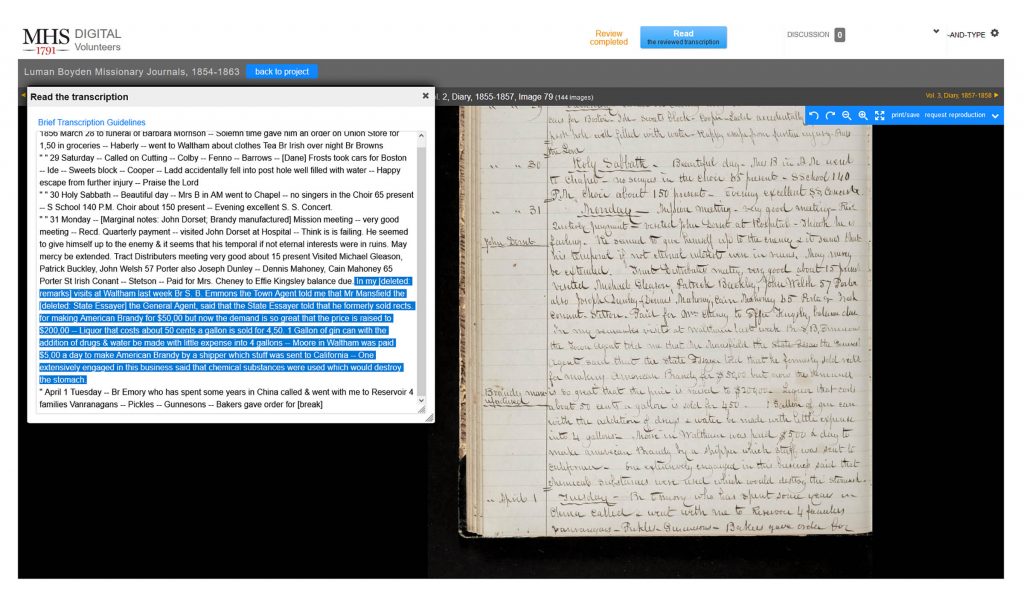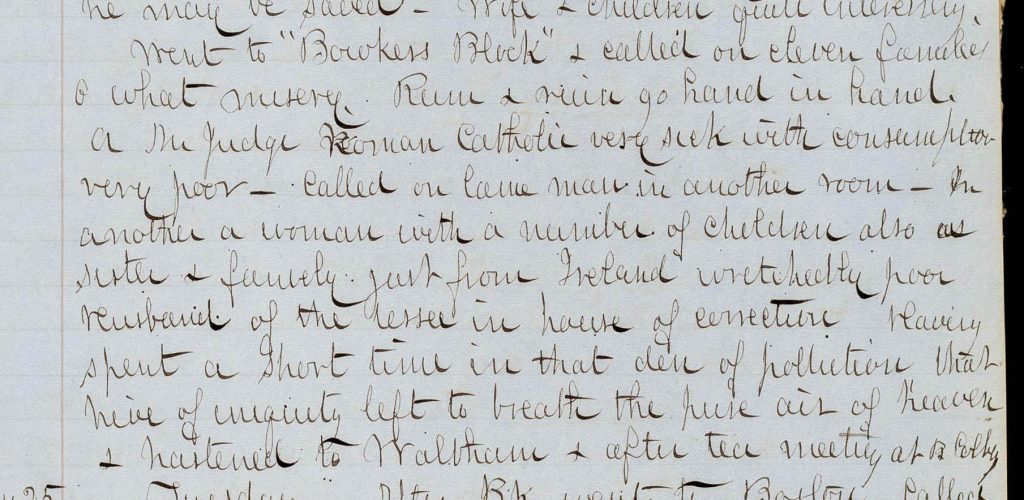By Kathy Griffin, Collections Services Project Transcriber
Since the spring of 2022, we have been promoting a grant-funded, pilot project to enable crowd-sourced online transcription of MHS collections. This project offers a meaningful volunteer experience at the present time and in the future will facilitate research using those collections by people across the globe. I have been involved in this project both as a transcriber and as the principal reviewer/editor of the transcriptions as they are completed by volunteers. Crowdsourcing for transcription is particularly important in the 21st century, when fewer members of the new generation of researchers are able to read cursive writing, and those who can decipher the writing of earlier centuries are a rare commodity. For what use can historical manuscripts be, when no one can understand the written record? This article in The Atlantic, by Drew Gilpin Faust, stabs right into the heart of the matter. Our vast manuscript collections stored in archival repositories across the United States will be useless unless the items are digitized and transcribed for access.
Online transcription projects which reach across the globe to willing volunteers can bring together those who enjoy both solving handwriting puzzles, and reading the stories of the past. Accurate transcription is probably the most time-consuming aspect of a completed digital project. We have the technology for rapid delivery of digitized documents to a computer screen, but we cannot engage the researcher if they cannot read the documents. On the MHS website, the transcriptions completed during the pilot project are visible to anyone who creates an account and logs in to the MHS Digital Volunteers web page. In the future, the plan is for the transcriptions to be searchable on the MHS website and also visible to people browsing the manuscript collection guides relating to the transcribed pages.

The primary transcription project of this endeavor was deciphering the diaries of Lumen Boyden, a mid-19th-century Methodist minister employed by the Boston City Missionary Society as a missionary in East Boston for most of the documented time period 1854-1863. He was also employed as the preacher for the Union Chapel in East Boston, and as a representative of the Society for the Prevention of Pauperism, and for several other charitable endeavors. Boyden spent his daily rounds visiting East Boston families of all religions and ethnicities. There is a wealth of information on the every-day life of the poor people of the area, from food consumed, to religious habits, to the scourge of alcoholism among the populace, sickness, medicine, the weather, schooling, amusements, fires, floods, wages, cost of living, religious beliefs and practices, and so forth. The poverty, squalor, disease, and dreadful living conditions that Boyden encountered in East Boston, on a daily basis, rival anything described in Dickensian London. And this is what historical manuscripts really give to us: a snapshot, incomplete at best, but an important glimpse into the lives of those who came before us. Since the journals have already been described in more detail in a previous Beehive post I will not give any further detail of Boyden’s writing.

Went to “Bowkers Block” & called on eleven families & what misery. Rum & ruin go hand in hand. A Mr Judge Roman Catholic very sick with consumption very poor — Called on lame man in another room — In another a woman with a number of children also a sister & family just from Ireland wretchedly poor Husband of the lessee in house of correction Having spent a short time in that den of pollution that hive of iniquity left to breath the pure air of heaven & hastened to Waltham & after tea meeting at B Colby
From my point of view the pilot project has been a great success with only minor technical glitches along the way. I cannot speak to the technical stuff – people who know me will agree that I have a troubled relationship with technology – but I love the editing work and consider transcription to be my truest vocation, next to sorting and arranging 18th and 19th century American manuscript collections. There is nothing like solving a good handwriting mystery to make me feel the sort of satisfaction one hopes to derive from a job well done. We have had a dedicated and hard-working group of volunteers (most of whom we never meet in person!) who have given freely of their own spare time to help us bring these journals of Lumen Boyden to life on the screen. We are so grateful and fortunate to have volunteers who enjoy diving into the work, and who find the same pleasure that I do, in making manuscripts accessible online.
[Note: Funding from an anonymous organization supported the pilot crowdsourcing project in 2022 featuring the Luman Boyden missionary journals. Funding from the Massachusetts Society of the Cincinnati supported beta testing of transcription tool in the fall of 2021 featuring two volumes of the John Rowe diaries.]

